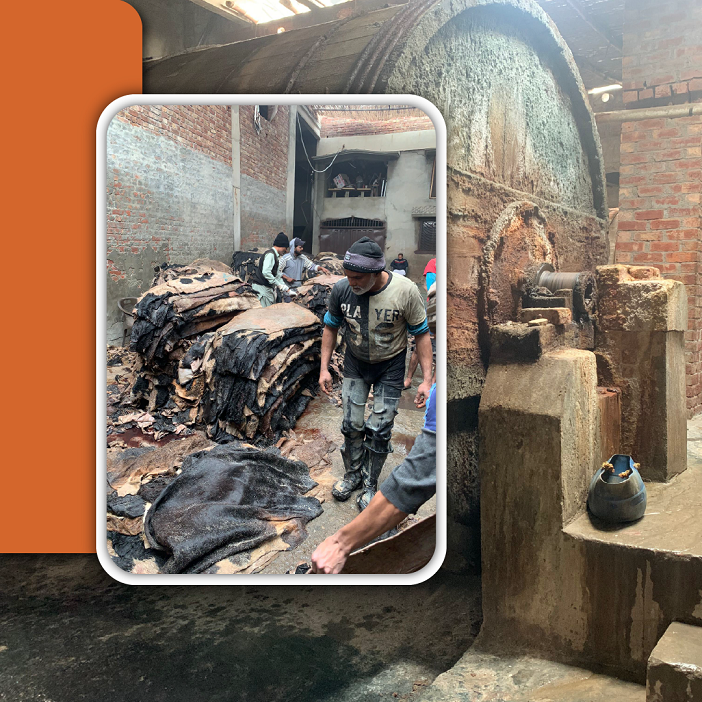The city of Kasur, known for Bulleh Shah and Noor Jahan, has been fighting the devastating effects of environmental pollution for half a century. A large number of people in the city and its suburbs are dealing with cancer, gastrointestinal diseases, and malformed bones or teeth due to the use of underground water.
Government departments and non-governmental organisations attribute this situation to the polluted water discharged from the local leather industry (tanneries), openly acknowledging the issue. However, to date, they have not found a satisfactory solution.
Tanneries in Kasur have been operating since the creation of Pakistan, and due to being a profitable business, this industry has continued to flourish. Their number has increased to 230 in Dingarh, Niaz Nagar, and Iqbal Nagar areas of the city.
The city became polluted due to the chemicals used in leather cleaning, the monopolies of the tannery owners, and the lack of seriousness of the management. The stench and foul odours made people's lives miserable. When the underground water became undrinkable, the citizens started protesting.
International organisations stepped in. In 1996, the federal and provincial governments and the United Nations Development Programme (UNDP) jointly launched the 'Kasur Tanneries Pollution Control Project.' The UNDP contributed 25 lakh dollars for this project, and a local investment of 19 crores, 90 lakh rupees was involved.
Under the project, a large water treatment plant was established on Dipalpur Road to purify the polluted water discharged from the tanneries. In addition to removing leather residue, fat, hair, chromium and some other minerals were also extracted from it.
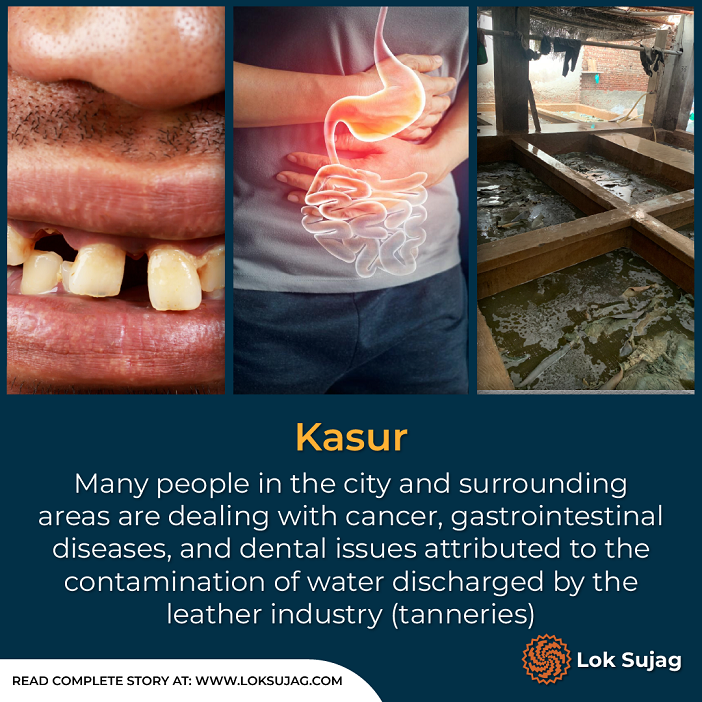
An autonomous body, the Kasur Tanneries Waste Management Authority (KTWMA), was established to oversee the project, including the treatment plant, with the Deputy Commissioner serving as the Managing Director. Its members included various government officials and a representative from the tanneries.
This institution worked well in the first few years, but the project fell into disrepair with time. During this time, the number of tanneries also increased. Once again, the polluted water was dumped into the Sutlej River without treatment.
The General Manager of KTWMA, Ghadif Mateen, says that the contaminated water from the tanneries reaches the treatment plant through a 3.8 kilometre (km) long paved drain.
"The treated water from the plant flows through an eight-km-long green channel into a raw canal (Rohi Nala). From there, it is discharged into the Sutlej River, five km away."
He says the average water discharge from the tanneries is eight thousand cubic meters daily. After Eid-ul-Adha, the activity here peaks, and the discharge reaches 19 thousand cubic metres.
"We estimate this from the readings of the water metres installed in the tanneries. The city's sewage water also gets mixed in, which makes all the estimates wrong. The management of 'in-flow' measurement in the plant is technically impossible."
According to the Kasur Tannery Pollution Control Project, the treatment plant's capacity is 13 thousand cubic meters per day (in case of a 24-hour operation).
The GM admits that due to a limited budget, the plant is run for only eight hours, and a large part of the water has to be dumped into the River Sutlej without treatment. He says the situation may be better if the sewage drain is separate.
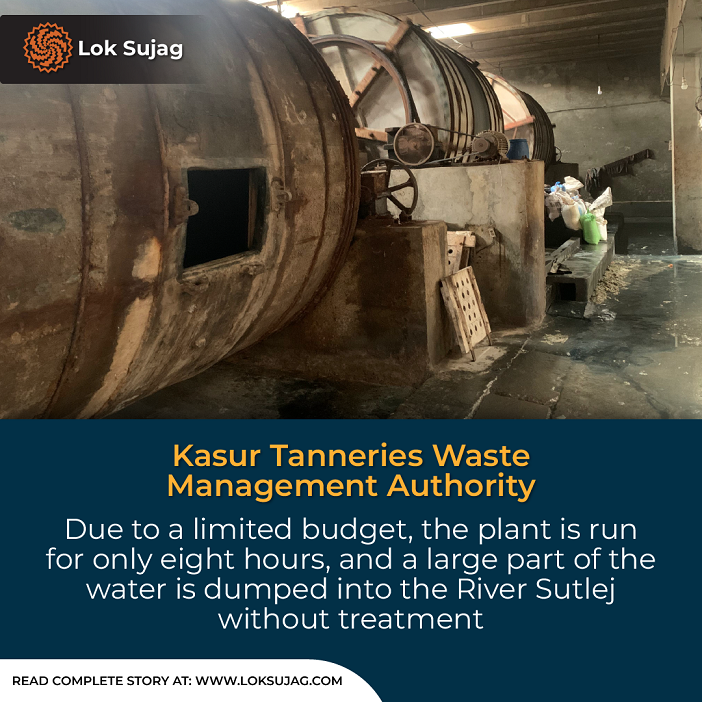
District Fisheries Officer Mueez Ahmed confirms that the polluted water from the tanneries is adversely affecting aquatic life as far as the Okara district. As the water flow in the river decreases, the animals, birds, trees, and marine life begin to die rapidly due to pollution.
In 2010, the district administration created a new cluster of tanneries named Iqbal Nagar and mandated the owners to install a chrome recovery plant in each of their tanneries. However, like Dingarh and Niaznagar, no one has set up any plant here.
Muhammad Owais, Chief of the NGO Good Thinker, states that due to the absence of plants in tanneries, polluted water is either discharged into the raw drain or mixed with underground water through boring.
He adds that residents in the villages around Iqbal Nagar complain of crooked bones and teeth, yet no attention is given to it.
Diseases are on the rise, and despite poverty, people are compelled to purchase drinking water.
The General Manager of KTWMA conveyed to the Provincial Secretary of Industries in a letter dated October 6, 2022, that, according to a Health Department survey, only two villages, Bangla Kumbawan and Dolewala, reported two cases of cancer, 99 cases of stomach disease, and 116 cases of skin disease.
Additionally, 50 cases of hepatitis were identified.
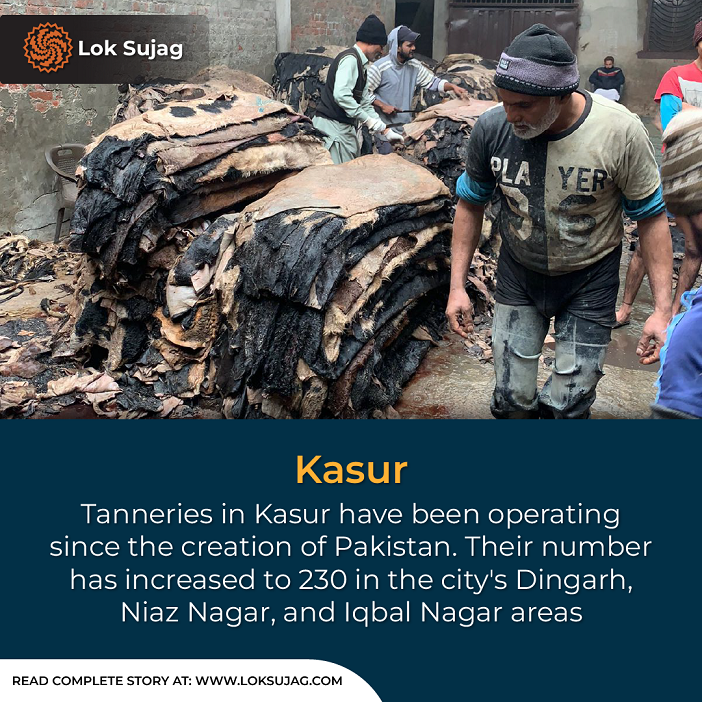
The GM acknowledges that the condition of dozens of villages, particularly Bangla Kumbawan, Hussain Khanwala, Bahadurpura, Sheikh Ammad, Dolewala, Toluwala, Faqiriyewala, Kotla Sheikh Natha, Chorpura, Shamspura, Mangal Mandi, Nooriwala, and Bhidian Osmanwala, is worse due to the tanneries.
Chief Executive Health Authority Kasur, Dr Muhammad Talha, says drinking water with heavy metals (a high amount of TDS) is fatal. It causes cancer and chronic liver and kidney diseases. In particular, chromium affects the small intestine and the gastrointestinal tract, which is thought to be cancerous.
The Pakistan Tanneries Association claimed in its 2022 export strategy paper that the leather industry exported products worth 95 crores, 37 lakh dollars in the financial year from July 2021 to June 2022, with Kasur's tanneries holding a significant share.
In 2013, the Punjab government, KTWMA, and UNDP planned to initiate phase two of the pollution control project. This phase aimed to conduct biological treatment on the water purified from the existing plant, but no progress has been made in this regard.
In December 2022, the Environment Department conducted an analysis of underground water, revealing dangerously high levels of chromium, nitrates, and metals (TDS).
Based on this report, the Lahore High Court directed tannery owners in Kasur to install effluent treatment/chrome recovery plants in all units. However, only two factories complied with this directive.
The Judicial Water and Environment Commission increased pressure to install chrome recovery plants in tanneries. In a meeting on September 5 between the district administration and tannery owners, an agreement was reached to install chrome recovery plants. Punjab Small Industries Corporation (PSC) also agreed to provide easy loans for this purpose.
Also Read
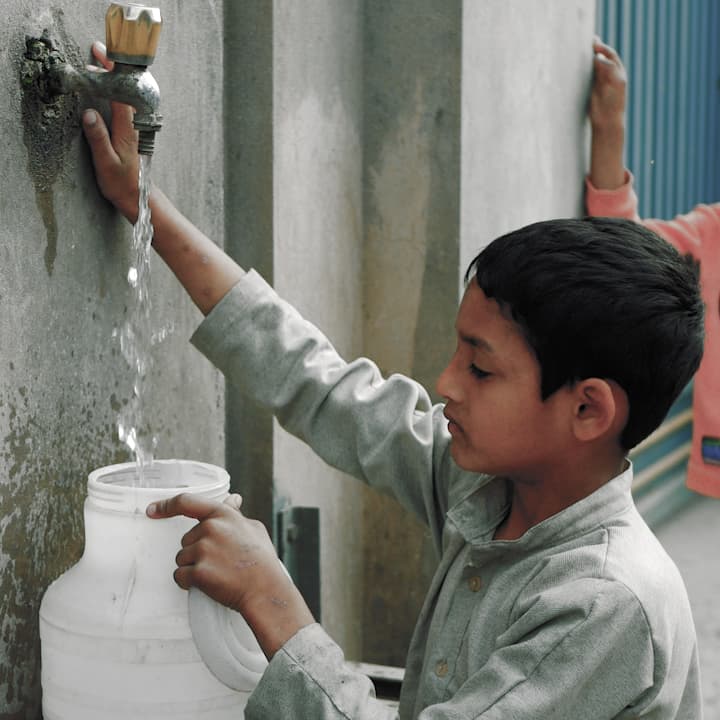
The deadly sweat of a factory: 'Ground water in Sambrial has become fully polluted'
During the next hearing of the pollution case, the Commissioner Lahore Division offered in the Lahore High Court that KTMWA was ready to hand over all the affairs to the tannery owners. The court issued (extendable) orders for three months.
The KTWMA has been handed over to the tannery owners in hopes of improvement. On November 10, an agreement was signed between KTWMA, tannery owners, and the district administration, according to which:
1. The contaminated water will be treated according to Punjab Environment Quality Standards before being discharged into the river. Chrome recovery plants will be installed in every tannery within three months.
2. The treatment plant will operate 24 hours daily, with the district administration closely monitoring all aspects. Weekly reports will be submitted to the High Court, Commissioner Lahore, the Environment Agency, and the Judicial Commission.
Now, the President of the Tanneries Association Dingarh (TAD) is the new Chairman (Managing Director) of the KTWMA.
The General Manager of KTWMA, two members of TAD, a representative of the Small Tanneries Association, and the Director of Environment, along with the District Accounts Officer (serving as Director of Finance), are members of the Authority.
TAD President Mian Shan Elahi claims that the district administration has failed to run the treatment plant. He intends to revive the plant, which has been closed for almost ten years, and initiate its operation soon.
Tannery owners, KTWMA, are defaulters of around Rs two crores. In this regard, Shan Elahi says that taking charge of the KTWMA from the administration was necessary. The dues will be collected in instalments from the defaulting tannery owners.
But the civil society, lawyers and businessmen here are not optimistic about this agreement.
Advocate Malik Shahnawaz says that making tannery owners fully responsible for KTWMA is 'like making a murderer the prosecutor of his trial.'
According to Waqas, CEO of NGO Goodthinker, tannery owners can't bear the cost of a water treatment plant and run it efficiently.
"To expect that would be like living in a fool's paradise."
However, Deputy Commissioner Muhammad Arshad Bhatti says the administration will fulfil its responsibility and deal with the tannery owners' dues later.
"For now, we have to hope for the best."
Tannery owner Muhammad Yusuf Saqlain says he is aware of the seriousness of the issue of contaminated water.
"We endorse the installation of treatment plants and are currently covering all expenses, amounting to approximately Rs 50 lakh per month, for KTWMA."
Published on 8 Jan 2024
